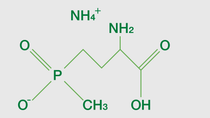Agriculture
How Does Glufosinate-Ammonium Work?
Glufosinate-ammonium is a plant protection product that works by inhibiting an enzyme central to plant metabolism. Plants absorb this substance primarily through their leaves and other green parts. As a contact herbicide, Glufosinate-ammonium is effective only where it comes into contact with the plant. This allows it to control weeds without affecting the roots or requiring tillage, which is important especially for erosion-prone areas such as slopes.
Effective against weeds while ensuring safety of crops
The primary mode of action of Glufosinate-ammonium is the inhibition of the enzyme glutamine synthetase. This enzyme catalyzes the synthesis of glutamine from glutamate and ammonia and plays a central role in plant nitrogen metabolism. This mode of action – unique among broad-spectrum herbicides – is key to mitigate developing resistance to other herbicides when used as part of an Integrated Weed Management (IWM) program. This includes the use of multiple herbicide modes-of-action as well as physical and biological weed control methods
If herbicides are not rotated due to limited availability or over-reliance on a few products such as Glyphosate, weeds that are naturally resistant will survive and propagate. The next generations will therefore have greater resistance, leading to significant crop damage.
The unique mode of action of Glufosinate-ammonium is an effective alternative to the commonly-used Glyphosate and other herbicides.
Additionally, Glufosinate-ammonium is a contact herbicide, which means that the active substance is only effective where it comes into contact with the plant. The herbicide is rapidly degraded in soil, avoiding that it enters ground water supplies. As only few treatments are needed per growing season, farmers avoid expending considerable energy and resources by applying multiple herbicides on the crop.

Did you know?
- Glufosinate-ammonium was first derived from cultures of soil bacteria Streptomyces viridochromogenesa and was found to be active as a herbicide in greenhouse tests in 1976.
- In many countries, Glufosinate-ammonium is also the only product on the market registered for the control of weeds and suckers – or new branches emerging from the roots of a tree – without harming the mother tree.





